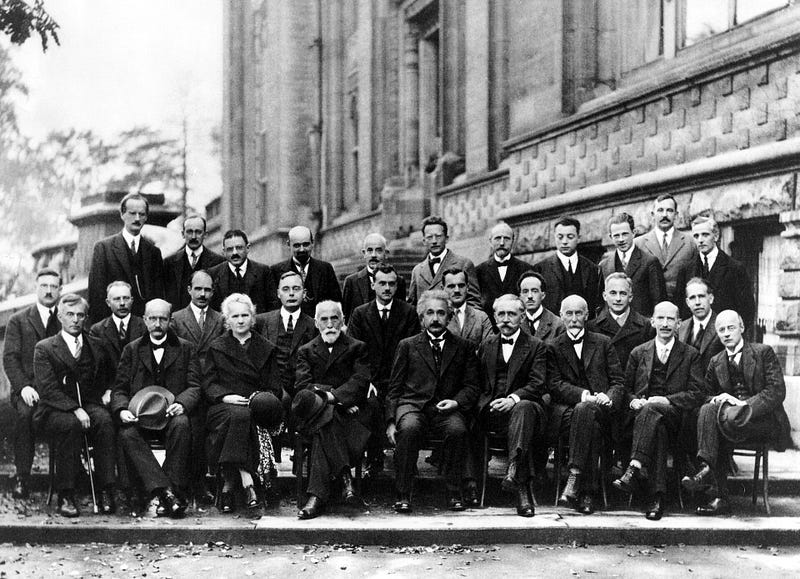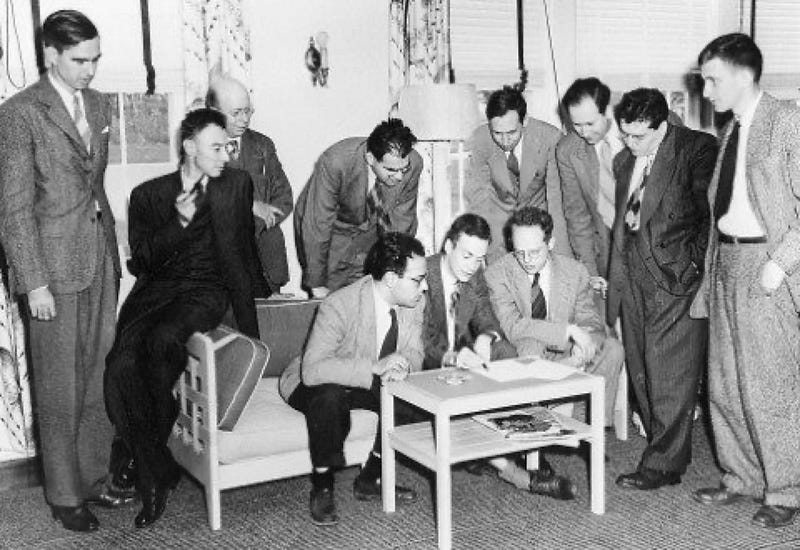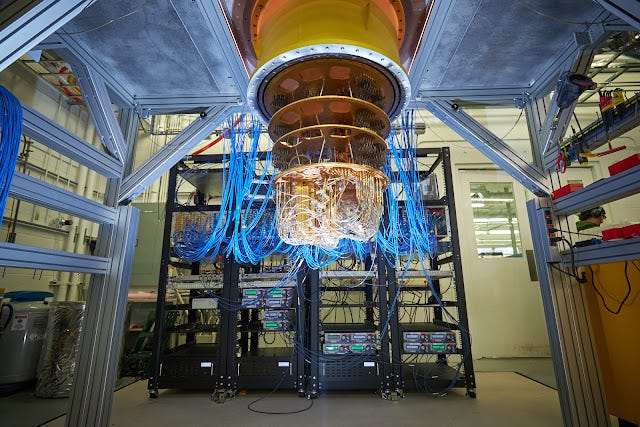
In 1925, something extraordinary happened. Physics, once rooted in certainty, was suddenly thurst into a domain of probabilities and paradoxes. Until then, the understanding of the natural world had seemed almost complete. Newton’s laws explained how objects moved. Maxwell’s equations described light and electromagnetism. Thermodynamics captured the flow of heat and energy.
Yet, all of these existing theories and laws could not explain the peculiar behavior of light, electrons, or atoms. To make sense of it all, scientists built an entirely new framework: quantum mechanics. It was a completely new language for describing the microscopic world, one where certainty was replaced with probabilities and the act of observing permanently changed what was being observed. The world hasn’t been the same since.
Fast forward to 2025, this year marks 100 years since quantum mechanics began to unravel the mysteries of the universe at its smallest scales. Designated as the International Year of Quantum, it offers a unique moment to reflect on a century of groundbreaking discoveries and celebrate how quantum science has transformed our understanding of reality and revolutionized the technologies that shape our daily lives. Let’s look back at a century of quantum breakthroughs and glimpse its future possibilities.
The Birth of Quantum Mechanics (1925–1930s)
The early 20th century was a period of great progress but also growing puzzles in physics. The laws of classical mechanics, so successful in describing planetary motion and everyday phenomena, failed spectacularly at atomic scales.
One of the first cracks appeared with Max Planck’s solution to the blackbody radiation problem in 1900. Planck proposed that energy is quantized and that it comes in discrete packets called quanta! Five years later, Einstein extended this idea, using the notion of a quanta to explain the photoelectric effect, where light hits a metal surface and frees electrons from the metal, and these freed electrons could conduct electricity. These discoveries fundamentally changed how we thought about the world, of light and of ordinary matter, and completely defied classical or common reasoning.
Niels Bohr, one of the pioneers of quantum theory, built on these early insights. In 1913, Bohr introduced his groundbreaking model of the atom, where electrons orbit the nucleus in discrete energy levels. His work bridged classical and quantum ideas, showing how electrons could jump between levels by absorbing or emitting quanta of energy. Bohr’s atomic model was a crucial step in linking quantum ideas to observable phenomena.
By 1925, Werner Heisenberg introduced matrix mechanics, a mathematical framework that described the behavior of particles like electrons. A year later, Erwin Schrödinger developed a formulation of wave mechanics, showing that particles’ behavior could also be described by considering them waves. These two seemingly different approaches were later unified under the emerging theory of quantum mechanics, where the dual nature of light and matter is seamlessly weaved. Quantum mechanics introduced a profound shift: the idea that we cannot know everything about a particle with absolute precision was revolutionary.
Max Born, another key figure in this period, played a pivotal role in interpreting this new quantum framework. Born realized that Schrödinger’s wave equation did not describe the exact position of a particle but rather the probability of finding it in a particular place. This probabilistic interpretation of quantum mechanics became one of its defining features, marking a sharp departure from the deterministic world of classical physics into a probabilistic one, where quantum particles existed as waves of possibility or wavefunction until observed.

The Coming of Age (1930s–1960s)
By the 1930s, quantum mechanics had become the standard framework for understanding the microscopic world. But it was far from being a complete picture. Scientists began extending its principles to more complex systems, making discoveries that would redefine both physics and technology.
One of the first major breakthroughs was Paul Dirac’s work in 1928. His Dirac equation predicted the existence of antimatter, confirmed with the discovery of the positron in 1932. Dirac’s work was a major milestone, not only did it definitively validated the otherwise new and counterintuitive ideas of quantum mechanics, but it showed how quantum mechanics could also describe fundamental particles and forces whose existence itself was not known as yet. Antimatter, though rare in our universe, would later find applications in medical imaging and remains a focus of high-energy physics research today.
Quantum mechanics also provided a new understanding of atoms, molecules, and chemical bonds. It explained why electrons occupy discrete energy levels and how they form the intricate patterns in the periodic table. This knowledge laid the groundwork for advances in chemistry and material science, enabling the design of new substances and compounds.
By the 1940s, physicists were refining quantum theory to unprecedented levels of precision. Quantum electrodynamics (QED), developed by Richard Feynman, Julian Schwinger, and Sin-Itiro Tomonaga, became the most accurate scientific theory ever created. QED describes how light interacts with matter at the quantum level, using Feynman diagrams to simplify calculations of complex particle interactions. Its predictions matched experiments to extraordinary accuracy, solidifying the predictive power of quantum mechanics.
One of the most consequential applications of quantum and nuclear physics during this time was the development of the atomic bomb. The Manhattan Project, a secret U.S. wartime effort during World War II, harnessed the principles of quantum mechanics and nuclear fission to release immense amounts of energy by splitting atomic nuclei. Grounded in discoveries like Einstein’s mass-energy equivalence equation E=mc², the bomb was a grim demonstration of how theoretical breakthroughs could be turned into tools of ultimate power. The recent blockbuster movie Oppenheimer brought this period back into public discourse, reminding us of the profound scientific and ethical dilemmas of this era.
While the atomic bomb marked the beginning of the nuclear age, it also laid the foundation for peaceful applications of nuclear science. By the late 1940s and 1950s, the same principles of fission were adapted to create nuclear reactors, providing a highly efficient energy source capable of powering entire cities. Advances in nuclear science also revolutionized medicine, as isotopes were developed for cancer treatment and diagnostic imaging, transforming healthcare and saving countless lives.
As the theoretical foundations grew, so did the practical applications. The transistor, invented in 1947, revolutionized electronics by controlling the flow of electrons in ways that classical physics could not explain. Based on quantum principles, the transistor has became the backbone of modern electronics and semiconductor industry, powering everything from radios to the microchips in today’s smartphones and computers.
In 1960, another milestone emerged in the invention of the laser. Using quantum principles of light emission, lasers became indispensable in medicine, communication, and even everyday tools like barcode scanners and precision devices. These technologies marked the first wave of the quantum revolution, where theoretical insights began translating into devices that shaped everyday life.
Even as quantum mechanics powered technological progress, it continued to challenge our understanding of reality. Einstein, skeptical of its probabilistic nature, famously debated with Niels Bohr about the completeness of quantum theory, saying, “God does not play dice.” These debates culminated in John Bell’s 1964 theorem, which provided a framework to test quantum entanglement. Subsequent experiments confirmed entanglement as a real phenomenon, validating what Einstein had famously described as “spooky action at a distance”.

The Second Quantum Revolution (1980s–Today)
By the mid-20th century, quantum mechanics had established itself as the cornerstone of modern physics. It explained the structure of atoms, the stability of matter, and the interactions between particles and light with unparalleled accuracy. But it was in the 1980s that a new phase of quantum exploration began. This phase, often called the Second Quantum Revolution, shifted the focus from understanding quantum mechanics to applying some of its strangest properties like superposition, entanglement, and interference, to build entirely new technologies.
One of the boldest ideas of this era came from Richard Feynman, who, in 1981, posed a seemingly simple question: Why not use quantum systems to simulate other quantum systems? Feynman recognized that classical computers struggled to model quantum behavior because they lacked the ability to handle the complexity of quantum states. This idea sparked the birth of quantum computing, a field that would soon redefine what computers could do. Unlike classical computers, which process information in binary (0s and 1s), quantum computers use qubits, which can exist in superpositions of states. This allows them to perform parallel or simultaneous computations and tackle complex problems that would take classical computers millions of years to solve.
In 1994, Peter Shor demonstrated this potential by developing an algorithm that could factor large numbers exponentially faster than any classical method. This breakthrough had profound implications for cryptography, as it threatened the security of widely used encryption systems. Quantum key distribution (QKD) uses the principles of entanglement to detect eavesdropping attempts. This ensures that messages remain confidential, even in the face of powerful hacking quantum computers. Meanwhile, quantum sensors, which leverage superposition and entanglement, are being developed for applications as diverse as medical imaging, gravitational wave detection, and climate monitoring.
The Second Quantum Revolution is no longer confined to the lab. Around the world, governments, industries, and academic institutions are investing heavily in quantum research, recognizing its potential to drive the next wave of technological innovation.
Europe has taken the lead with the European Quantum Flagship, a €1 billion initiative spanning ten years. Its goal is to accelerate the development of quantum technologies in fields like computing, communication, and sensing, while fostering collaboration across academia and industry. This effort has already produced prototypes of quantum networks and laid the groundwork for future quantum-based infrastructure.
In the United States, the National Quantum Initiative Act, signed into law in 2018, aims to maintain the country’s leadership in quantum science. With billions in funding, it has created quantum research hubs that bring together universities, national laboratories, and private companies. These hubs are tackling challenges like scaling quantum computers, improving quantum sensors, and training the next generation of quantum scientists and engineers.
China, another major player in today’s quantum race, is investing heavily in projects like its quantum satellite, Micius, which has demonstrated entanglement-based communication over long distances. The country is also building a 2,000-kilometer-long quantum communication network, aimed at creating a highly secure national infrastructure.
Beyond national programs, private industry is pouring resources into quantum research. Tech giants like IBM, Google, and Microsoft are competing to build scalable quantum processors, while startups like Rigetti and IonQ push the boundaries of hardware and software innovation. Industries ranging from pharmaceuticals to logistics are exploring how quantum algorithms can solve problems classical methods cannot.

2025 and Beyond: What’s to Celebrate?
A hundred years after Heisenberg and Schrödinger’s groundbreaking contributions, quantum mechanics continues to shape the modern world in ways both profound and surprisingly familiar. It powers technologies we use every day, often without us even realizing it. The transistors in your phone and computers’ microchips, the LEDs illuminating your screen, and the precise positioning provided by GPS satellites are all technologies that rely on quantum mechanics. Even medical imaging tools like MRI machines owe their remarkable precision to the quantum properties of atomic nuclei. Also lasers, emerging as an application of quantum theory, they are now indispensable in everything from internet communication to barcode scanning. These everyday applications are living proof of how quantum mechanics has quietly revolutionized modern life, transforming theoretical insights into practical tools that we often take for granted.
What makes 2025 truly worth celebrating is not just the quantum legacy of the past, but the promise of the future. We are on the brink of the Second Quantum Revolution, where the most exotic aspects of quantum mechanics like superposition, entanglement, and interference, are being harnessed to build technologies that could redefine what is possible.
Quantum computers, for example, could one day solve problems that are currently beyond the reach of classical computers. From simulating complex molecules for drug discovery to optimizing global supply chains, their potential spans a wide range of industries. Quantum networks, built on the principles of entanglement, could create a secure internet, where information is transmitted with absolute confidentiality. Meanwhile, advanced quantum sensors could revolutionize medicine, environmental monitoring, and navigation, achieving levels of precision that were once unimaginable.
These large-scale efforts bridge the gap between fundamental research and real-world applications, ensuring that quantum mechanics continues to transform industries and improve lives. Governments, international collaborations, and private sector competition are propelling remarkable progress in quantum technologies and reshaping the technological landscape of the 21st century.
The quantum future, however, is not without its challenges. Scaling quantum systems to practical, everyday use remains a daunting task. It requires breakthroughs in materials science, quantum error correction, and engineering. At the same time, fundamental questions about quantum mechanics itself remain unanswered. How does quantum mechanics connect with gravity, the force that governs the largest scales of the cosmos? Could it offer insights into the origins of space and time, pushing our understanding beyond the Big Bang?
These unanswered questions remind us that quantum science is not just about technology. It is about exploration, curiosity, and pushing the boundaries of human knowledge. The future is quantum, and it is only just beginning.


